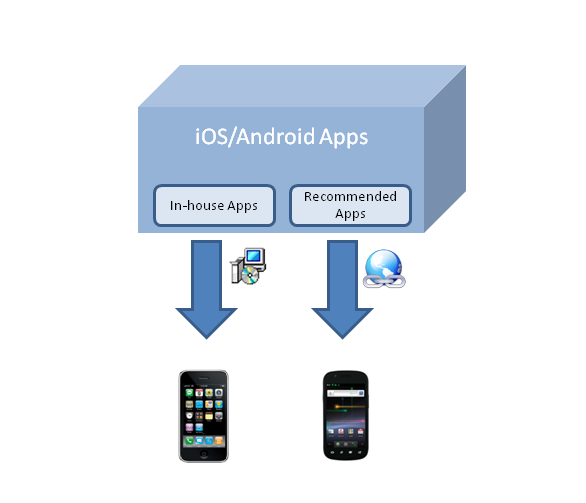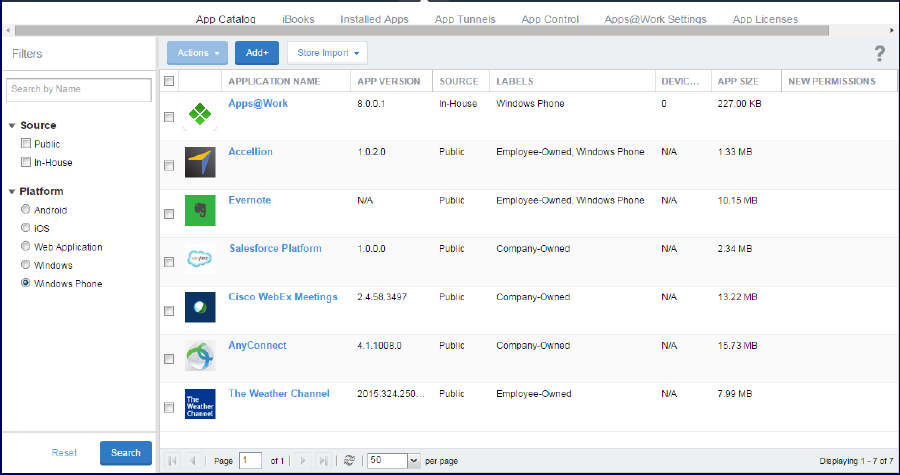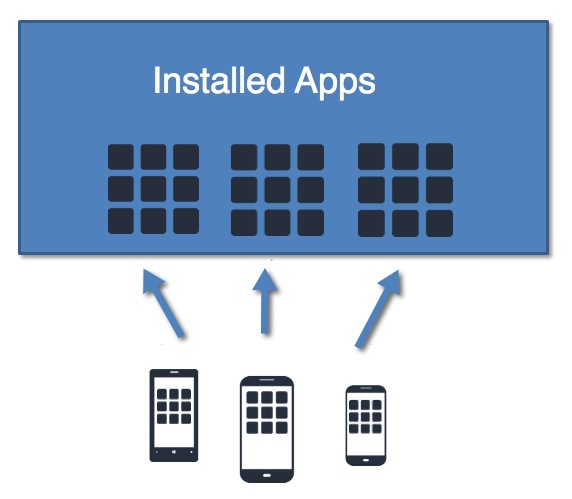About managing mobile apps
Apps@Work provides the tools for distributing and managing mobile apps. You can use Apps@Work tools to facilitate installation of standard corporate apps, as well as to help regulate the apps that your users are bringing into the enterprise. Apps@Work tools consist of:
- App Catalog (previously called “app distribution library”)
- App Control
- Installed Apps (previously called “device app inventory”)
What is the App Catalog?
The Ivanti Endpoint Manager Mobile (Ivanti EPMM) App Catalog is a centralized location for the business apps you want to manage for your users. App distribution is customized for each supported platform, and allows you to set granular policies per app. By uploading apps to the App Catalog, you can make private apps available for users to download on their devices. You can also add external apps and distribute them to users, making it clear to employees that the apps are approved for download and supported.
With the App Catalog, you can:
- Include apps from the Apple Store, Google Play Store, or Windows Store.
- Upload in-house apps to the App Catalog.
- If your Ivanti EPMM is enabled for Android Enterprise, include private apps for Android Enterprise devices that are hosted on Google Play Store for your domain.
You can then make these apps available for users to download with Apps@Work on their devices.
Due to a limitation from Apple, for Business-to-Business (B2B) iOS apps available in the App Catalog, only the descriptions of the apps are available in the Details tab. Screenshots are not available.
The Apps@Work home page on the device consists of three rows. Each row is separate section made up of:
- New Releases
- Featured Apps
- Categories of Apps
You can easily identify apps selected by the administrator as a featured app. These apps are displayed in a banner at the top of the screen. Swipe the banner to scroll through the featured apps. Featured apps are also displayed in a section listing the apps in a row on the Apps@Work home screen. Tap More to see all the apps in the that section. you can also tap the search icon at the top to search for an app.
To list an app in the Featured app banner in the Apps@Work home page:
- Go to Apps > App Catalog, on the Ivanti EPMM Admin Portal and select an app and click on 'Edit', 'Add' or view the app details.
- Select Feature Banner.
- Add a Short Description. The description is blank by default.
-
Select the Light Banner Style option. You can see what your banner will look like in the Preview.
The Dark, Blue, Green and Orange options will work in a later release.
- Select Finish.
Apps deployed by the Administrator within the last 30 days are displayed in a New Releases section on the Apps@Work home page.
Select an app to view the Detail screen to see the app’s ratings, size, developer, install status and more. In this view, click Install to install the app on your device. A Pending install message displays when installation is in progress.
All apps that users download from Apps@Work are considered managed apps.
Figure 1. All apps downloaded from Apps@Work are Managed apps

Figure 2. App Catalog page in Ivanti EPMM

Use the App Catalog to:
- Add, configure, update, and remove managed apps
- Edit app configurations
- Install and upgrade managed apps to devices using labels
- Set the prerequisite app for a dependent app
- Indicate mandatory installation of prerequisite apps in Apps@Work
- Group apps into categories to be displayed in Apps@Work on the device
- View app details at a glance, such as the:
- App name, size, and version number
- Label(s) to which the app is applied
- Origins of the app (public or in-house)
- Number of devices, and list of devices, to which the app is deployed
- New permission status: an icon appears if the app requires new permission
For detailed instructions on working with apps for each platform, see:
Also, see Managing apps on MAM-only devices, if you are working with MAM-only Android or iOS devices, which are devices for which Ivanti EPMM does not support device management (MDM).
App Catalog Device Details page
The Device Details page for the App Catalog tab displays information about devices, but also allows administrators to take actions.
Procedure
- Log in to Ivanti EPMM.
- Select Apps > App Catalog.
- Select the Source and the Platform.
- Locate the app.
- Use the search box or sort columns to quickly find the app you want.
- Click the number link in the Devices Installed column.
In addition to viewing the device details, you can take the following actions from this page:
- Send a message to a device
- Force a device to check-in
- Indicate if an app must be installed (mandatory)
- Retire a device
- Export to device data (from the table) to an Excel .csv file
Ivanti EPMM does not support viewing device information for apps installed on MAM-only iOS devices.
Exporting App Catalog data
Manage data more easily by exporting app data from the App Catalog to an Excel spreadsheet.
Procedure
- Log in to Ivanti EPMM.
- Select Apps > App Catalog.
- Select the Source and the Platform.
- Locate the app.
Use the search box or sort columns to quickly find the app you want. - Click the number link in the Devices Installed column to open the Device Details page.
- Click Export to CSV to create an Excel spreadsheet containing the details of the selected app.
- Locate the .csv file, open, modify, and save, as necessary.
The exported spreadsheet contains the following information:- Device UUID
- User Name
- User ID
- Platform
- Model
- Mobile Number
- Device Space
- App Version
- Managed
- App Name
- App Identifier
Ivanti EPMM does not support exporting App Catalog data for apps installed on MAM-only iOS devices.
What is App Control?
The App Control feature enables you to exert control over which apps are installed on managed devices.
Using app control rules, you can define which apps are allowed, disallowed, or required (for iOS, macOS, and Android only). You can then associate these rules with a security policy that specifies the consequences of being out of policy. Note that Ivanti EPMM does not support app control rules for MAM-only iOS and Android devices.
App control is achieved through a collaboration between the app control rules, Security policy, and alerts:
- The app control rules define which apps you want to control.
- The security policy specifies which devices the rules are applied to and the actions to associate with a rule violation.
- The alert determines the information that is sent as the result of rule violation, and the recipients of the information.
Figure 3. App Control

What are Installed Apps?
The Installed Apps feature presents a snapshot of the apps installed across your managed devices. The Apps > Installed Apps page displays the apps that have been reported as installed on each device. You can use this list to track new apps coming into the enterprise, determine the popularity of apps, and identify possibly rogue apps.
Privacy policy settings determine how devices report their installed apps to Ivanti EPMM.
Figure 4. Installed Apps

Ivanti EPMM does not support viewing installed apps on MAM-only iOS devices.
For more information, see Managing app inventory.
Best Practice: label management
If Notes for Audit Logs is enabled, whenever a change is made to a label, a text box displays for the administrator to provide a reason for the change.
This affects the following label-related activities:
- Add/Edit/Delete/Save Label (Both filter and manual)
- In Devices & Users > Devices > Advanced Search > Save to Label
- Add/Edit/Remove Label to devices
- Add/Edit/Remove Label to configurations
- Add/Edit/Remove Label to policies
- Add/Edit/Remove Label to apps
- Add/Edit/Remove Label to iBooks
Example text to enter would be a change ticket order number. This information then displays in the Audit logs, in the Details column as "Reason."

The Notes for Audit Logs feature is also applicable to any administrator-made changes to iOS and macOS restrictions.
To enable this feature, see "Setup tasks" in Getting Started with Ivanti EPMM.